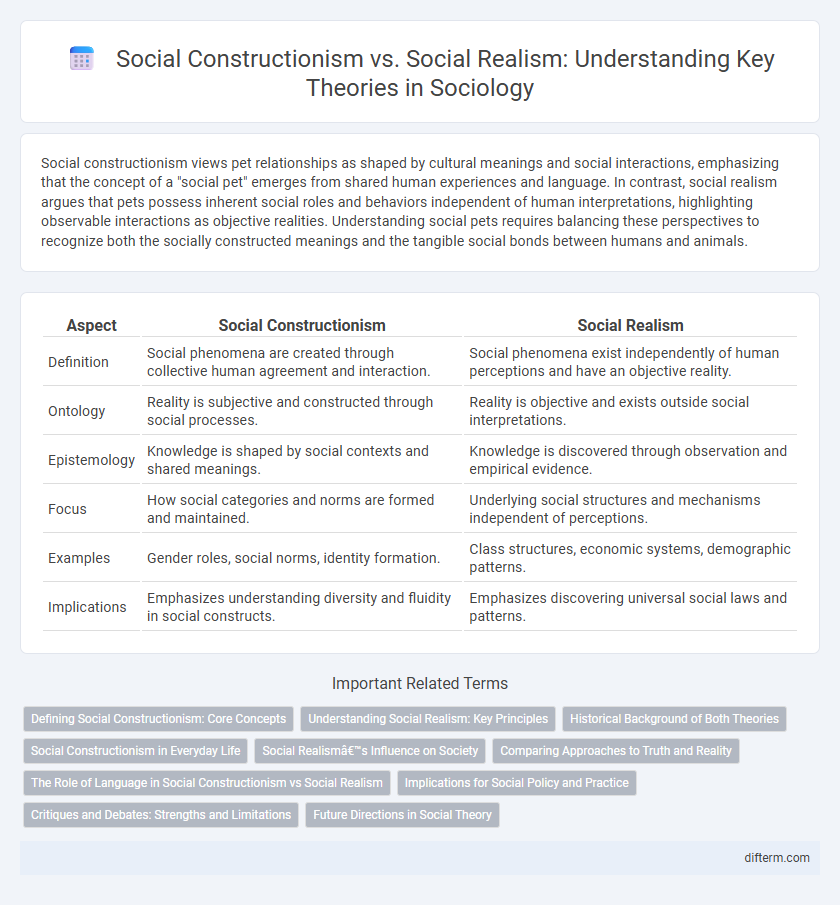Social constructionism views pet relationships as shaped by cultural meanings and social interactions, emphasizing that the concept of a "social pet" emerges from shared human experiences and language. In contrast, social realism argues that pets possess inherent social roles and behaviors independent of human interpretations, highlighting observable interactions as objective realities. Understanding social pets requires balancing these perspectives to recognize both the socially constructed meanings and the tangible social bonds between humans and animals.
Table of Comparison
| Aspect | Social Constructionism | Social Realism |
|---|---|---|
| Definition | Social phenomena are created through collective human agreement and interaction. | Social phenomena exist independently of human perceptions and have an objective reality. |
| Ontology | Reality is subjective and constructed through social processes. | Reality is objective and exists outside social interpretations. |
| Epistemology | Knowledge is shaped by social contexts and shared meanings. | Knowledge is discovered through observation and empirical evidence. |
| Focus | How social categories and norms are formed and maintained. | Underlying social structures and mechanisms independent of perceptions. |
| Examples | Gender roles, social norms, identity formation. | Class structures, economic systems, demographic patterns. |
| Implications | Emphasizes understanding diversity and fluidity in social constructs. | Emphasizes discovering universal social laws and patterns. |
Defining Social Constructionism: Core Concepts
Social constructionism centers on the idea that social realities are created through collective human agreement and shared meanings, emphasizing how language, culture, and interactions shape perceptions of truth and knowledge. It challenges the assumption that social facts exist independently of human cognition, instead highlighting the fluidity and context-dependence of social phenomena. Core concepts include the co-construction of reality, the role of discourse in framing experiences, and the dynamic nature of identities and institutions as products of social negotiation.
Understanding Social Realism: Key Principles
Social realism emphasizes that social structures and realities exist independently of individual perceptions, grounding these phenomena in objective conditions and material contexts. It argues that societal institutions and norms have causal powers that shape human behavior and interactions beyond mere social agreements. Understanding social realism requires recognizing the interplay between individual agency and the authoritative nature of social realities.
Historical Background of Both Theories
Social constructionism emerged in the mid-20th century, influenced by the works of Peter L. Berger and Thomas Luckmann, who emphasized how social realities are created through collective human agreement and interaction. Social realism, with roots in Marxist theory and critical sociology, focuses on how social structures and material conditions exist independently of individual perceptions and shape social phenomena historically and materially. Both theories have evolved through academic debates to address the dynamic relationship between human agency and objective social realities in sociological inquiry.
Social Constructionism in Everyday Life
Social constructionism asserts that everyday realities and meanings are created through social interactions and shared understandings, emphasizing the fluid and negotiated nature of knowledge. This perspective highlights how language, cultural norms, and social practices shape perceptions of identity, truth, and social roles within communities. By focusing on the social origins of knowledge, social constructionism challenges objective views of reality and emphasizes the collaborative creation of meaning in daily life.
Social Realism’s Influence on Society
Social realism profoundly shapes society by emphasizing the objective structures and material conditions that influence human behavior and social institutions. This perspective highlights how societal realities such as class, economic systems, and institutional power maintain and reproduce social inequalities. Its impact is evident in policy development and social critiques aimed at addressing tangible social issues beyond mere subjective interpretations.
Comparing Approaches to Truth and Reality
Social constructionism argues that truth and reality are shaped through social processes, emphasizing the role of language, culture, and power dynamics in constructing knowledge. Social realism, by contrast, asserts that an objective reality exists independently of human beliefs, aiming to uncover underlying truths through empirical investigation. The key distinction lies in social constructionism's focus on how social contexts influence perceptions of reality, while social realism maintains that reality remains constant regardless of social interpretation.
The Role of Language in Social Constructionism vs Social Realism
Language shapes reality in social constructionism by creating shared meanings and social norms through communication, emphasizing the fluidity and context-dependence of knowledge. In contrast, social realism views language as a medium that reflects pre-existing social structures and objective realities independent of linguistic interpretation. The role of language thus diverges: it is a constructive force in social constructionism and a representational tool in social realism.
Implications for Social Policy and Practice
Social constructionism highlights that social realities are shaped by collective human perceptions, urging policymakers to prioritize flexible, context-sensitive approaches that accommodate diverse social narratives. Social realism asserts the existence of objective social structures influencing behavior, encouraging policies grounded in empirical evidence to address systemic inequalities and institutional constraints. Integrating both perspectives can enhance social policy and practice by balancing subjective experiences with structural realities to inform effective and inclusive interventions.
Critiques and Debates: Strengths and Limitations
Social constructionism emphasizes the role of language and cultural practices in shaping social reality but faces critiques for sometimes underestimating objective structures influencing human behavior. Social realism argues for the existence of an independent social reality, yet it struggles with explaining how knowledge about this reality is socially mediated and constructed. Debates highlight the strengths of constructionism in addressing power relations and context, while realism provides a firm grounding for empirical investigation, revealing limitations in both approaches regarding the balance between subjective experience and objective conditions.
Future Directions in Social Theory
Future directions in social theory emphasize integrating insights from social constructionism and social realism to address complex social phenomena. Emerging research explores how social realities are co-constructed through shared meanings while recognizing material structures that influence behavior and institutions. This hybrid approach advances understanding of power dynamics, identity formation, and evolving social practices in digital and global contexts.
social constructionism vs social realism Infographic

 difterm.com
difterm.com